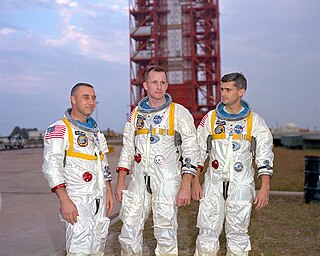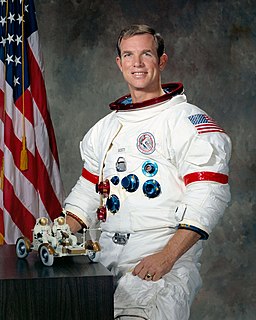
Apollo 11 was the spaceflight that first landed humans on the Moon. Commander Neil Armstrong and lunar module pilot Buzz Aldrin formed the American crew that landed the Apollo Lunar Module Eagle on July 20, 1969, at 20:17 UTC. Armstrong became the first person to step onto the lunar surface six hours and 39 minutes later on July 21 at 02:56 UTC; Aldrin joined him 19 minutes later. They spent about two and a quarter hours together outside the spacecraft, and they collected 47.5 pounds (21.5 kg) of lunar material to bring back to Earth. Command module pilot Michael Collins flew the Command Module Columbia alone in lunar orbit while they were on the Moon's surface. Armstrong and Aldrin spent 21 hours, 36 minutes on the lunar surface at a site they named Tranquility Base before lifting off to rejoin Columbia in lunar orbit.

The Apollo program, also known as Project Apollo, was the third United States human spaceflight program carried out by the National Aeronautics and Space Administration (NASA), which succeeded in landing the first humans on the Moon from 1969 to 1972. It was first conceived during Dwight D. Eisenhower's administration as a three-person spacecraft to follow the one-person Project Mercury, which put the first Americans in space. Apollo was later dedicated to President John F. Kennedy's national goal for the 1960s of "landing a man on the Moon and returning him safely to the Earth" in an address to Congress on May 25, 1961. It was the third US human spaceflight program to fly, preceded by the two-person Project Gemini conceived in 1961 to extend spaceflight capability in support of Apollo.

Apollo 1, initially designated AS-204, was the first crewed mission of the United States Apollo program, the undertaking to land the first man on the Moon. It was planned to launch on February 21, 1967, as the first low Earth orbital test of the Apollo command and service module. The mission never flew; a cabin fire during a launch rehearsal test at Cape Kennedy Air Force Station Launch Complex 34 on January 27 killed all three crew members—Command Pilot Virgil I. "Gus" Grissom, Senior Pilot Ed White, and Pilot Roger B. Chaffee—and destroyed the command module (CM). The name Apollo 1, chosen by the crew, was made official by NASA in their honor after the fire.

Extravehicular activity (EVA) is any activity done by an astronaut or cosmonaut outside a spacecraft beyond the Earth's appreciable atmosphere. The term most commonly applies to a spacewalk made outside a craft orbiting Earth. On March 18, 1965, Alexei Leonov became the first human to perform a spacewalk, exiting the capsule during the Voskhod 2 mission for 12 minutes and 9 seconds. The term also applied to lunar surface exploration performed by six pairs of American astronauts in the Apollo program from 1969 to 1972. On July 21, 1969, Neil Armstrong became the first human to perform a moonwalk, outside his lunar lander on Apollo 11 for 2 hours and 31 minutes. On the last three Moon missions astronauts also performed deep-space EVAs on the return to Earth, to retrieve film canisters from the outside of the spacecraft. Astronauts Pete Conrad, Joseph Kerwin, and Paul Weitz also used EVA in 1973 to repair launch damage to Skylab, the United States' first space station.

Neil Alden Armstrong was an American astronaut and aeronautical engineer, and the first person to walk on the Moon. He was also a naval aviator, test pilot, and university professor.

A space suit or spacesuit is a garment worn to keep a human alive in the harsh environment of outer space, vacuum and temperature extremes. Space suits are often worn inside spacecraft as a safety precaution in case of loss of cabin pressure, and are necessary for extravehicular activity (EVA), work done outside spacecraft. Space suits have been worn for such work in Earth orbit, on the surface of the Moon, and en route back to Earth from the Moon. Modern space suits augment the basic pressure garment with a complex system of equipment and environmental systems designed to keep the wearer comfortable, and to minimize the effort required to bend the limbs, resisting a soft pressure garment's natural tendency to stiffen against the vacuum. A self-contained oxygen supply and environmental control system is frequently employed to allow complete freedom of movement, independent of the spacecraft.

Michael Collins is an American astronaut who flew the Apollo 11 command module Columbia around the Moon while his crewmates, Neil Armstrong and Buzz Aldrin, made the first crewed landing on the surface. He was a test pilot and major general in the U.S. Air Force Reserves.

Col. David Randolph Scott, USAF, Ret. is a retired test pilot and NASA astronaut who was the seventh person to walk on the Moon. The commander of Apollo 15, Scott was selected as an astronaut as part of the third group in 1963. Scott flew three times in space, and is the only living commander of an Apollo mission that landed on the Moon and one of four surviving Moon walkers. Following the deaths of James Irwin in 1991 and Alfred Worden in 2020, Scott is now the last surviving crew member of Apollo 15.

ILC Dover, LP is an American special engineering development and manufacturing company based in Frederica, Delaware. ILC specializes in the use of high-performance flexible materials, serving the aerospace, personal protection, and pharmaceutical industries.

The Apollo/Skylab space suit is a class of space suits used in Apollo and Skylab missions. The names for both the Apollo and Skylab space suits were Extravehicular Mobility Unit (EMU). The Apollo EMUs consisted of a Pressure Suit Assembly (PSA) aka "suit" and a Portable Life Support System (PLSS) that was more commonly called the "backpack". The A7L was the PSA model used on the Apollo 7 through 14 missions.

The Kennedy Space Center Visitor Complex is the visitor center at NASA's Kennedy Space Center in Florida. It features exhibits and displays, historic spacecraft and memorabilia, shows, two IMAX theaters, and a range of bus tours of the spaceport. The "Space Shuttle Atlantis" exhibit contains the Atlantis orbiter and the Shuttle Launch Experience, a simulated ride into space. The center also provides astronaut training experiences, including a multi-axial chair and Mars Base simulator. The visitor complex also has daily presentations from a veteran NASA astronaut. A bus tour, included with admission, encompasses the separate Apollo/Saturn V Center. There were 1.7 million visitors to the visitor complex in 2016.

The Gemini space suit is a space suit worn by American astronauts for launch, in-flight activities and landing. It was designed by NASA based on the X-15 high-altitude pressure suit. All Gemini spacesuits were developed and manufactured by the David Clark Company in Worcester, Massachusetts.

Space Center Houston is a science museum which serves as the official visitor center of NASA Johnson Space Center in Houston. It earned a place as a Smithsonian Affiliate museum in 2014. The organization is owned by NASA and operated under a contract by the nonprofit Manned Spaceflight Education Foundation, a 501(c)(3) organization. The Johnson Space Center is the home of Mission Control and astronaut training.

The United States Astronaut Hall of Fame, located inside the Kennedy Space Center Visitor Complex Heroes & Legends building, honors American astronauts and features the world's largest collection of their personal memorabilia, focusing on those astronauts who have been inducted into the Hall; as well as Sigma 7, the fifth manned Mercury spacecraft, and also the Gemini IX spacecraft.

The Constellation Space Suit was a planned full pressure suit system that would have served as an intra-vehicular activity (IVA) and extra-vehicular activity (EVA) garment for the proposed Project Constellation flights, which were planned to begin after the Space Shuttle retired. The design of the suit was announced by NASA on June 11, 2008, and it was to be manufactured by Houston, Texas-based Oceaneering International, the first company other than the David Clark Company, Hamilton Sundstrand, and ILC Dover to produce life-support hardware, as a prime contractor, for in-flight space use.

The Stafford Air & Space Museum is located in Weatherford, Oklahoma, United States. The museum, named for NASA astronaut and Weatherford native Thomas P. Stafford, became a Smithsonian Affiliate in June 2010. The museum features exhibits about aviation, space exploration, and rocketry, and a collection of over 20 historic aircraft. Displays include artifacts from the Space Shuttle program, Hubble Space Telescope, and the Mir Space Station, a Moon rock, Stafford's Apollo 10 spacesuit, the Gemini 6A spacecraft, a Titan II missile, and a Mark 6 re-entry vehicle.

The American Space Museum is a museum in Titusville, Florida. It includes the US Space Walk of Fame, an outdoor plaza on the Indian River that honors both the astronauts and the NASA and contractor personnel who made American manned space exploration possible. The monuments surround a pool and are dedicated to the Mercury, Gemini, Apollo and Space Shuttle programs. The museum houses related exhibits and artifacts and is located at 308 Pine Street.

The Launch Entry Suit (LES), known as the "pumpkin suit", is a partial-pressure suit that was worn by all Space Shuttle crews for the ascent and entry portions of flight from STS-26 (1988) to STS-65 (1994). It was completely phased out by STS-88 and replaced by the ACES suit. The suit was manufactured by the David Clark Company of Worcester, Massachusetts.

Joseph W. Schmitt was a spacesuit technician for the National Aeronautics and Space Administration manned space exploration program in the 1960s and 70s. As "suit tech," he was on close terms with the astronauts and was usually the last person to have direct contact with them before their missions. Schmitt suited up Alan Shepard for his mission at the beginning of Project Mercury and continued to work on the Gemini, Apollo and Skylab programs, ending his career during the early Space Shuttle Program. As an essential part of the final stages of preparation for space flight, Schmitt was depicted in many photographs, leading to his inclusion in two works on the subject by Norman Rockwell.

The personal preference kit (PPK) are containers used to carry the personal items and souvenirs of astronauts during the Gemini and Apollo program's and the Space Shuttle flights. Items that astronauts chose to carry into space were approved by NASA management and stored in PPKs.


























